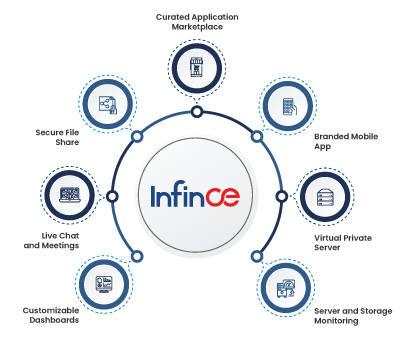Embracing cloud technologies is one of the typical components of digital transformation. According to a Gartner report, “By 2024, more than 45% of IT spending on system infrastructure, infrastructure software, application software, and business process outsourcing will shift from traditional solutions to the cloud.” This statement speaks aloud how cloud computing is becoming the most disruptive technology for businesses in this digitally forward era.
As with adopting any technology, moving to the cloud also requires having a robust plan. Most organizations move to multiple clouds to make the most of the technology and have the utmost flexibility. This is where the hybrid cloud comes into the picture, as it facilitates all the demands of such enterprises by providing paramount agility and cost-efficiency. However, it is also seen that a hybrid cloud infrastructure can create many security vulnerabilities if it is not deployed properly.
Read more: Top Cloud Trends Your Enterprise Should Pursue to Succeed in 2021 and Beyond!
How to Deploy a Hybrid Cloud Approach Perfectly
Hybrid cloud infrastructure merges the workloads on the public and private cloud to allow enterprises receive the best of both models. This gives businesses enhanced flexibility to shift their cloud and on-premise workloads as and when required. Hybrid cloud is also a better option because it allows organizations to have better control over their data. Companies can store their sensitive data on the private cloud while they can manage the other workloads on the public cloud. At the same time, they can have a unified platform to configure and manage the capabilities of both and enjoy simplified administration.
It is a known fact that cybersecurity concerns are on the rise, which is why enterprises that move with their digital transformation strategies also need a reliable approach to avoid cyberattacks. Reports say that most of the data breaches in recent years have been due to the misconfiguration of cloud services. In fact, it comes only second to hacking. Although migrating to the cloud allows businesses to prevent that by outsourcing the services to a reliable partner, it does not make the cloud totally protected from cyberattacks. That is why cloud services providers are stressing the need for adopting identity and authentication approaches to improve security.
Read more: 6 Ways InfinCE Simplifies IT Infrastructure Management For Enterprises
How IAM Can Bridge the Gap in Cloud Security
Identity and Access Management (IAM) can be a vital ingredient in protecting access to resources and data in a hybrid cloud environment. With a hybrid cloud identity strategy in place, businesses can rest assured that only the right people with pre-defined, secure digital access can use the resources and data. It is like an authentication authority for the hybrid cloud infrastructure, with capabilities like Multi-Factor Authentication (MFA) and Single Sign-On (SSO), which reinforce cybersecurity. Apart from that, hybrid cloud identity can also allow for seamless experiences for the employees and customers, in turn leading to improved overall productivity.
Cloud SSO can reduce the usage of traditional passwords, which can not only provide a better employee experience but also decrease the costs of password resets. On the other hand, IAM in the hybrid cloud can help to boost customer satisfaction and loyalty rates by providing secure, password-less logins and unified profiles. At the organizational level, IAM helps to monitor user access to the distributed resources over the public and private clouds. Administrators can set specific rules for users and grant them different levels of access based on their job roles and requirements.
Who Needs a Hybrid Cloud Identity and Access Management Solution?
A hybrid cloud IAM solution can also be integrated and deployed at any level, regardless of whether the data and resources are stored and managed on the public cloud or in the on-premise data center. However, it is essential that enterprises identify their IT and business requirements before deploying hybrid cloud IAM so that it fits their needs in the best way. Ensuring this alignment between the varied demands of the company will be a key defining factor in the efficiency of a hybrid cloud IAM solution.
Read more: How InfinCE Cloud Orchestration Platform Can Be A Game Changer For New Business Owners
Companies That Operate Globally
Large enterprises with branches all over the world usually have a huge suite of applications that they use on a daily basis to manage their workflow. These apps and resources can have complex requirements and may require re-architecting to make them compatible with the hybrid cloud infrastructure. Therefore, such organizations retain some apps to be managed in on-premise data centers while deploying others on the public cloud. This makes it imperative for such enterprises to ensure high-end security on both ends to keep their data and resources secure.
This is where hybrid cloud IAM becomes the preferred option by allowing the company to secure applications at every level as necessary. When defining Identity and Access Management (IAM), Gartner says that “Enterprises that develop mature IAM capabilities can reduce their identity management costs and, more importantly, become significantly more agile in supporting new business initiatives.” With a hybrid cloud IAM solution, they can integrate and secure local workloads while defining enhanced security for the resources on the cloud.
Companies That Need to Comply With Regulatory Requirements
Many enterprises need to fulfill specific regulatory requirements, especially if they are doing business on a global scale. This can range from local regulatory norms to national data residency requirements. According to a Gartner report on market trends and cybersecurity, “Personal data privacy has become an intangible asset in this data era. Protecting privacy by standing on the consumers’ side is a differentiator to build a strong brand for any company that is in the consumer business.”
As hybrid cloud IAM is built to support data sovereignty, it allows such companies to host and store their data required for a specific location in that region, while managing globally intensive data on the public cloud. Meanwhile, they can also define user access and control over the data access, usage, and sharing with a well-designed hybrid cloud IAM strategy in effect. That in turn allows such businesses to ensure compliance on every level without compromising on customer expectations.
Companies That Look to Reduce IT Costs
As businesses are becoming increasingly digital-dependant, the IT and admin teams are required to deal with a wide variety of requests. At the same time, they may have to work with limited resources while having to deliver a broader range of requirements. With a hybrid cloud identity plan in place, businesses can save significantly on IT operational costs while not having to cut the quality or amount of support they have been providing to their customers.
Hybrid cloud IAM allows enterprises to handle the challenging use cases efficiently without having to break the bank for the same. It can facilitate centralized identity management on the enterprise level as well as across multiple clouds while providing the tools to automate and maintain the IAM solution. In other words, hybrid cloud identity allows organizations to free up their IT staff from managing infrastructure, which helps them to focus on other higher-value activities.
Read more: Why InfinCE Digital Workplace Should be Your Remote Work Companion
Start the Hybrid Cloud Journey Today
Having a smart digital transformation strategy is what businesses need today to stay competitive in the industry. As migrating to the cloud can be described as a stepping-stone toward digital transformation, enterprises need to realize the flexibility a hybrid cloud infrastructure can provide. Know more on how a hybrid cloud identity solution can boost security, improve productivity, and deliver seamless experiences for the employees and partners. Connect with us today, or Sign Up with InfinCE for free to experience infinite cloud for your business.





